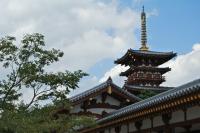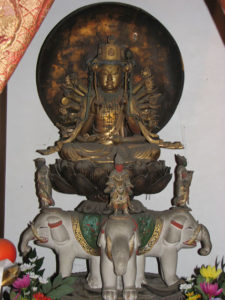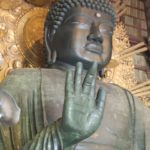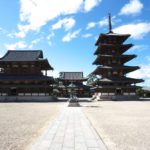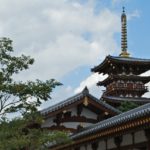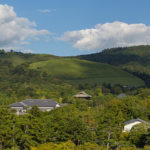Table of Contents
Buddha statue of Bosatsu(Bodhisattva)
A Buddha statue of Bosatsu represents a figure of Buddha when he sought enlightenment. In Sanskrit language, Bosatsu is called as “Bodhisattvaa“.
Sponsored Links
“Bodhi” means enlightenment and “sattvaa” is who lives. He is in the stage of trainning to be Nyorai who achieves it. Because he had been a prince of a royal family in ancient India, he had worn many accessories.
Related Post
Kannon-bosatsu(観音菩薩, Avalokiteśvara)
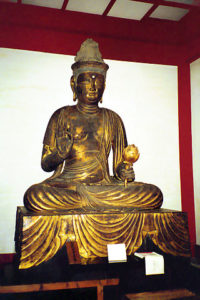
It is also called “Sho-kannon”(聖観音) . “Kannon” means watching and hearing people. Kannon-Bosatsu always pays attention for them and come to the rescue immediately when they need help. The God would change himself into other six Kannon-bosatsu such as Nyoirin-kannon, Senju-kannon, Juichimen-kannon, and Fukuken-kannon.
They often have a lotus flower or a water jug. The lotus flower is the symbol of purity because it comes out from mad but keep its clearness. And the water jug contains inexhaustible blessing water.
Nyoirin-kannon (如意輪観音, Cintāmaṇicakra)
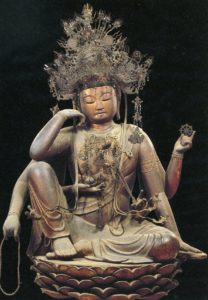
One of the six Kannon. “Nyoi”(如意) is the Cintamani stone which gives people any wisdom, fortune and happy. “Rin”(輪) is the ring of the Buddha, which can smash their worldly desires.
Mostly they have six arms for helping people and make a gesture of contemplation how to save them with one knee up. And they put their sole of the foot together, the way of sitting “Rinno-za”(輪王座) .
Senju-kannon(千手観音, Sahasrabhuja ārya avalokiteśvara)
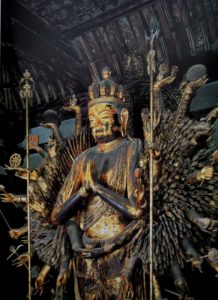
The formal name is “Senju sengan zizai kannon”(千手千眼自在観音). It means the God has a thousand arms and a thousand eyes, and can lead people to the teaching of Buddha. But most of the Buddha statues don’t have a thousand exactly except one at Toshodaiji Temple (唐招提寺).
In general, they only have forty-two arms for simplifying. The eyes are attached to each hand. They often have the twenty-eight guardians(Nijuhachi-bushu, 28部衆) and Deva king(Kongo rikishi, 金剛力士) in tow.
You can see the masterpieces of the Buddha statue at Toshodaiji in Nara and Sanjusangendo(三十三間堂) in Kyoto.
Juichimen-kannon(十一面観音, Ekadaśamukha)
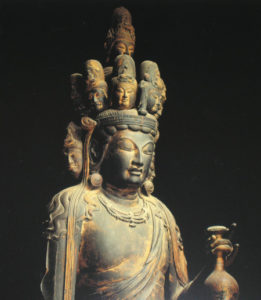
Since Nara Period, people had faith in this Bosatsu. The Buddha statues have literally eleven faces to watch over whether there is anyone who is struggling.
The small faces on the head show that front three of them are marciful, the left side of three are angry, the right side of three are gentle, behind one is laughing, and the top is preaching. They often have a water jug in the left hand and make Semui-in(施無畏印) with the right hand.(learn more about the meaning of the Buddha’s hand)
Batoh-kannon(馬頭観音, Hayagrīva)
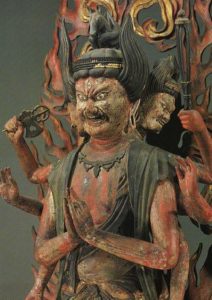
The Buddha statue also the one of the six kannon. The origin is one of the Gods of Hinduism, “Vishnu”, who can transform his head into a horse.
Unlike other Busatsu, the expression is in a rage for driving away distress and evil crimes. So they are often included in the eight Myoo(八大明王). And the horse head eats people’s worldly desires like as grass. They protect animals and people’s traveling and farming.
So you can see the statues on an old highway or a country road.
Fukukenjaku-kannon/Fukukensaku-kannon(不空羂索観音, Amoghapāśa)
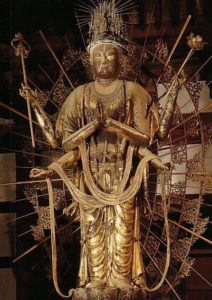
“Fuku”(不空) means if you believe, you never feel empty. And “Kenjaku”(羂索) is a rope for capturing animals and enemy. One of the six kannon. They help every people from troubles. Basically, they have eight arms and three eyes.
The production of the Buddha statues put on stream at Tenpyo Culture in Japan. You can see it of the lacquer structure at Todaiji in Nara.
Juntei-kannon(准胝観音, Cundā)
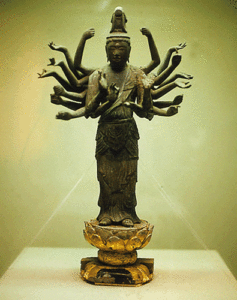
The origin of Juntei-kannon is one of the Gods of Hinduism, “Duruga” who is the Goddess of a war. But introduced in Buddhism, she became mercy mother of many Buddha. Most of the Buddha statue have eighteen arms and three eyes and show Seppo-in(説法印) and Semuin.
Miroku-bosatsu(弥勒菩薩, Maitreya)
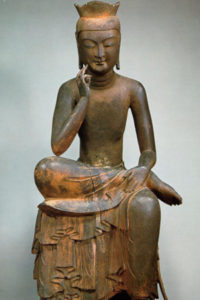
The name represents one who was born from mercy. Miroku-bosatsu is assured to be Nyorai after 5 billion 567 millions years from Buddha’s death. Miroku live in Tosotsu-ten(兜率天) where is the far upper world of the heaven.
They often a posture of “hankasii”(半跏思惟), bend the right knee and put it on the left. As like Nyoirin-kannon, the figure means meditating how to save people who wasn’t saved by Noyorai.
Monju-bosatsu(文殊菩薩, MaJjuzrii)
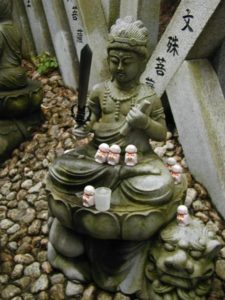
The Buddha statue is the bostatsu of wisdom judging whether it is correct or not. In Japan, there is a proverb “Sannin yoreba Monju-no chie”(三人寄れば文殊の知恵) which means that two heads are better than one.
Monju-bosatsu and Fugen-bosatsu are often attendant for Shaka-nyorai. Most of them hold a sword with the left hand and a sutla with the right hand and sit on the stand of the lotus flower which a lion puts on his back.
Fugen-bosatsu(普賢菩薩, Samanta bhadra)
Kokuzo-bosatsu(虚空蔵菩薩, Ākāśagarbha)
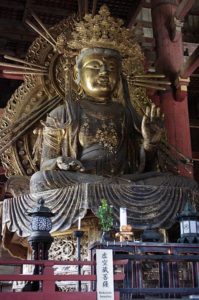
The meaning of “kokuzo”(虚空蔵) is a warehouse which contains unlimited, just like the universe, wisdom, and mercy. This bosatsu can remember everything as much as he like, and give people, memory, knowledge, and his Buddhism wisdom.
At the training of “Kumonziho”(求聞持法) which place the Buddha statue as the principal object, it has a lotus flower with a Cintamani stone in the left hand, shows “Yogan-in”(与願印) by the right hand. And on the most of their heads, there is “Gobutsu-hokan”(五仏宝冠) a crown with five Buddha faces.
Seishi-bosatsu(勢至菩薩, Mahaasthaamapraapta)
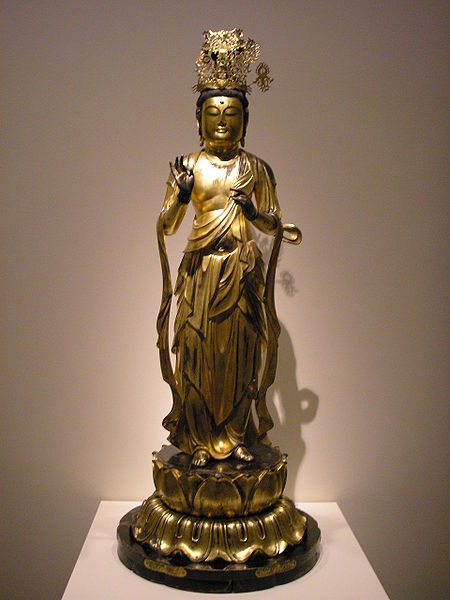
The God illuminate with its light of wisdom everywhere and help people. Most of the Buddha statue is stand as an attendant for Amida-nyorai with Kannon-bosatsu, and rarely alone. It often has a water jag or puts its hands together.
Zizo-bosatsu(地蔵菩薩, Kṣiti garbha)
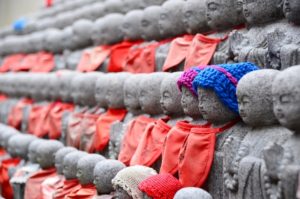
This is the most popular Buddha statue in Japan. You can see them at the roadside around the country rather than the temples. Japanese people are familiar them by calling “Ozizo-sama”(お地蔵様). When Miroku-bosatsu comes down to this world to save people, the God change the figure into Ozizo-sama.
It is also said that Ozizo-sama is the incarnation of the Great King Yama, the judge of the afterlife, and believed to be saved from the suffering of the hell. The figure of the Buddha statue is mostly a monk with gems or a bishop’s staff.
Nikko-bosatsu(日光菩薩, S rya-prabha). Gakko-bosatsu(月光菩薩, Candra-prabha)
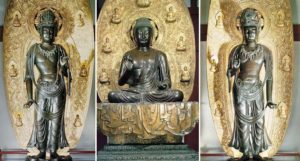
Both of them are attendant for Yakushi-nyorai(or Fukukenjaku-kannnon at Todaiji) and never placed independetly.
“Nikko”(日光) is the sunlight and “gakko”(月光) is the moonlight in Japanese. The sunlight gets rid of the darkness of humans and the moonlight envelops them in a gentle mercy. The Buddha statues are made in bilaterally symmetric.

